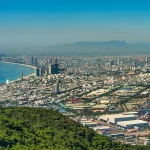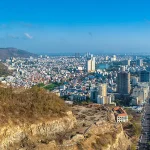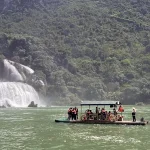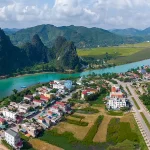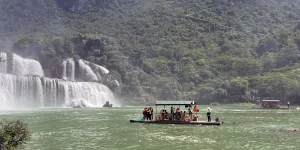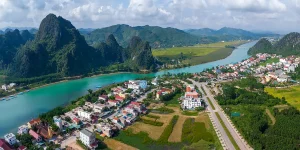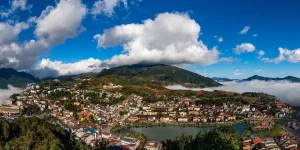With misty mountain roads, green valleys, and fast-moving rivers, this Southeast Asian country is full of surprises. Among its many natural sights, cascading streams and dramatic drops offer some of the most exciting places to explore. In this guide, we’ll take you on a regional journey through the most beautiful waterfalls in Vietnam.
We’ve divided the list into three areas: North, Central, and South Vietnam. For each waterfall, you’ll get practical tips — including entrance fees, the best time to go and how to get there. So let’s begin in the highlands of Northern Vietnam, where rivers cut through limestone cliffs and waterfalls pour into rice-covered valleys.
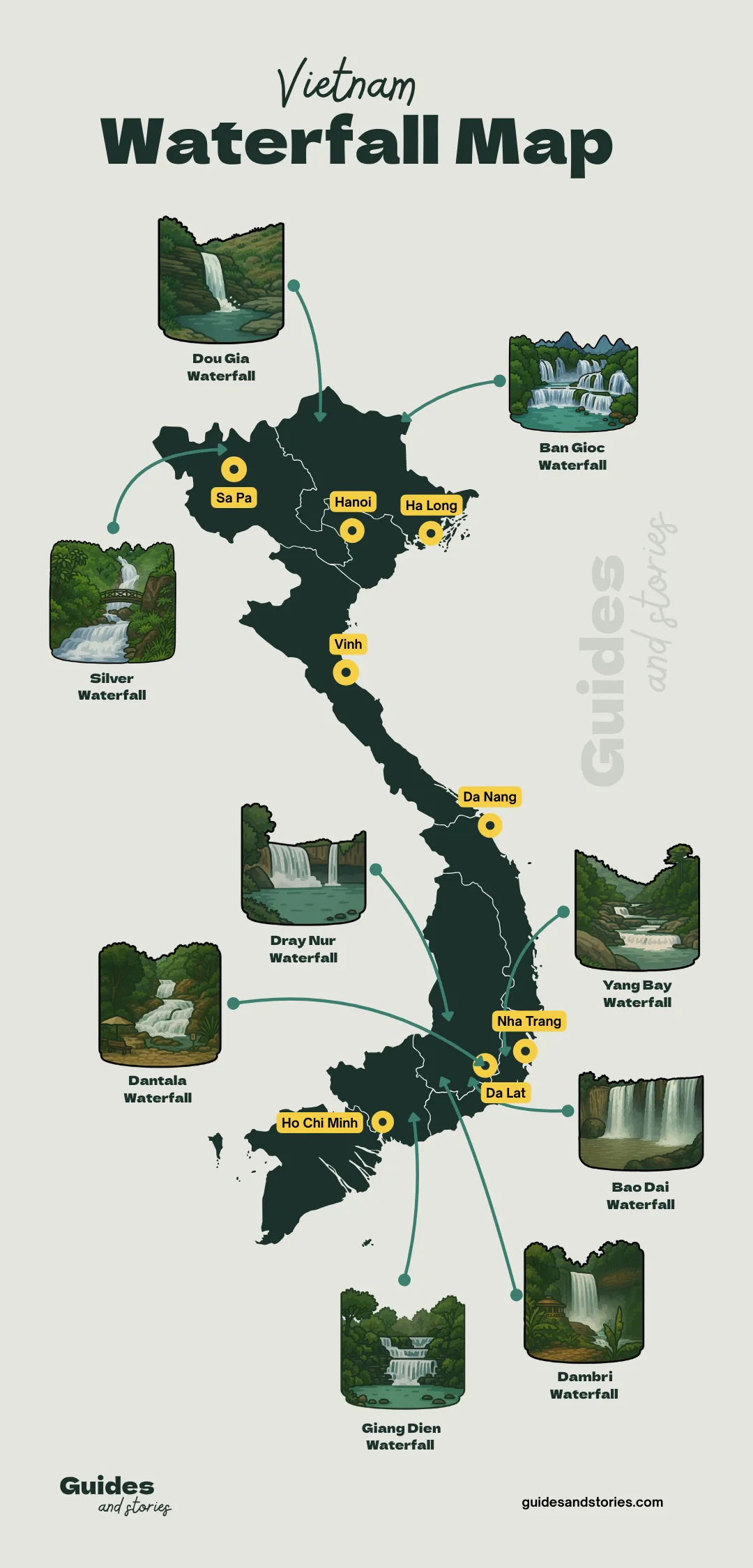
Table of Contents
Waterfalls in North Vietnam: Scenic Cascades in Mountain Valleys
Ban Gioc Waterfall — Vietnam’s Largest Waterfall Near the China Border

Located in Cao Bang province, Ban Gioc is the largest waterfall in Vietnam. It’s also one of the most beautiful and photo-friendly. It stretches nearly 985 feet (300 meters) wide and drops about 98 feet (30 meters) down.
It flows over several layers of limestone, right at the border between Vietnam and China. All around it, you’ll see green rice fields, bamboo forests, and tall karst mountains — making the view even more stunning.
Getting there:
About 2.5 hours (53 mi / 85 km) northeast of Cao Bang City by motorbike, private car, or on a local tour.
Best time to visit:
May to September — the rainy season fills the falls, creating a powerful flow and deep emerald waters.
Entrance price:
Approx. $2 (50,000 VND) per person.
Silver Waterfall (Thác Bạc) — A Quick Stop with Great Views Near Sapa
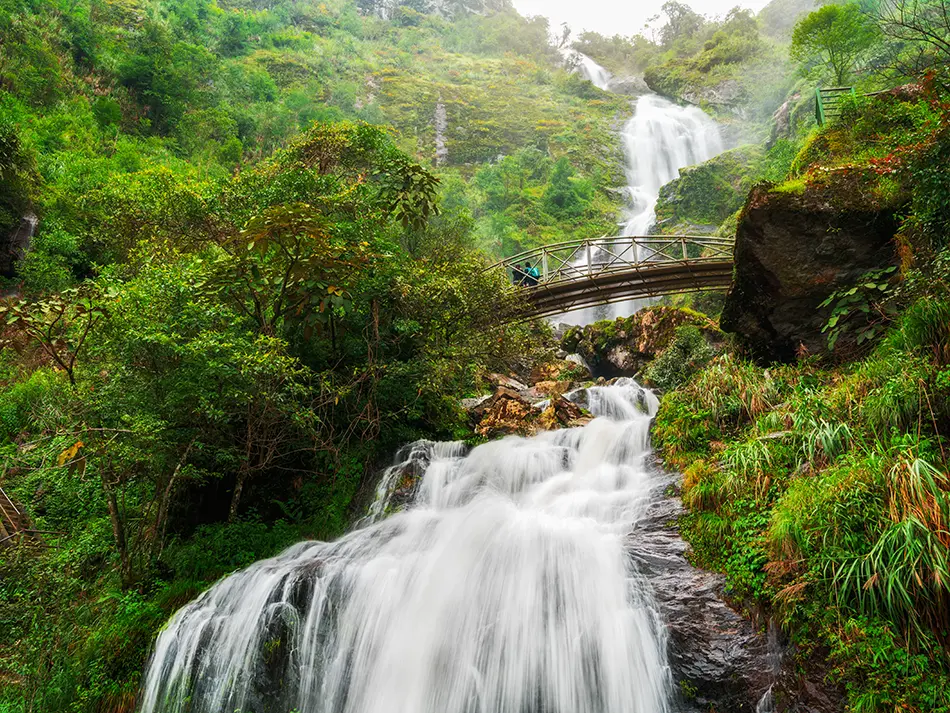
Just outside Sapa, in Lao Cai province, Silver Waterfall tumbles down from the Hoang Lien Son mountain range. This fast-moving cascade gets its name from the silver shine the water creates as it crashes over gray rocks — a sight that’s even more striking after rain.
At roughly 656 feet (200 meters) tall, it’s among the highest waterfalls in the region, and a popular stop for travelers exploring the scenic routes around Sapa.
Getting there:
Located just 30 minutes (7.5 mi / 12 km) west of Sapa, along the scenic road to Tram Ton Pass.
Best time to visit:
April to July for strongest water flow.
Entrance price:
About $0.80 (20,000 VND).
Mu Waterfall — A Forest Getaway with Natural Pools
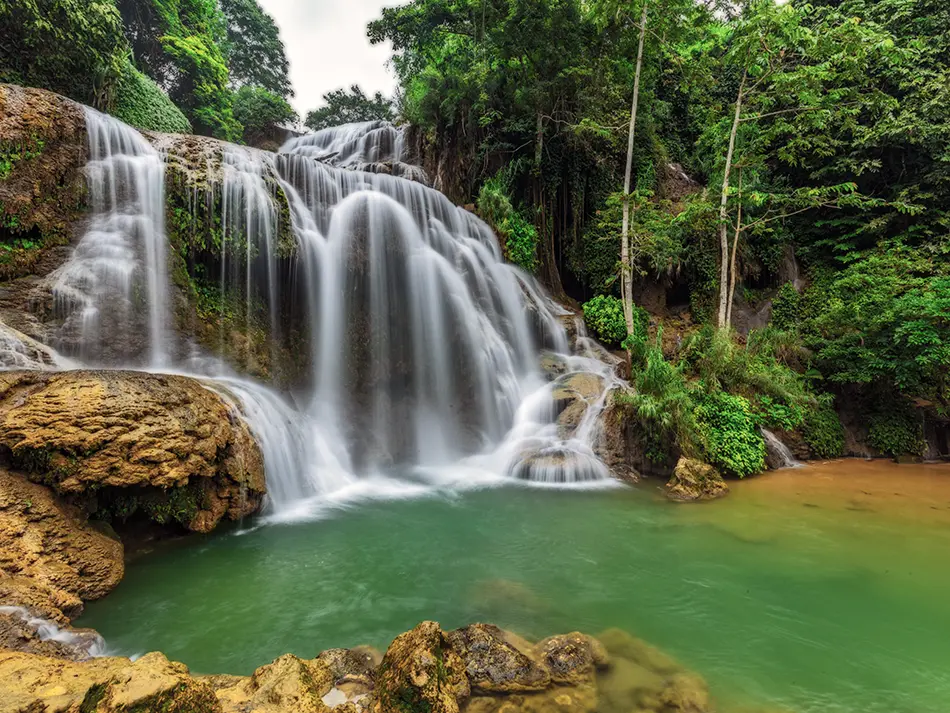
Tucked into the green hills of Hoa Binh province, Mu Waterfall offers a peaceful escape. It’s a favorite among local families and travelers looking for something less touristy. Unlike dramatic drops, this waterfall flows gently in a series of shallow cascades — perfect for swimming on a warm day.
The area is home to the Muong ethnic group, and several nearby eco-lodges offer overnight stays in traditional stilt houses, adding cultural depth to the visit.
Getting there:
From Hanoi, it’s approximately a 3.5-hour drive (87 mi / 140 km) southwest to Mu Village.
Best time to visit:
June to October — water levels are higher and the pools are perfect for a swim.
Entrance price:
Approx. $1.60 (40,000 VND).
Insider Tip
Combine your visit with a homestay experience to learn more about Muong culture — some offer homemade meals and guided hikes in the nearby forest.
Tac Tinh Waterfall — A Scenic Cascade with Local Legends

Located in Tam Duong district of Lai Chau province, Tac Tinh Waterfall drops from a height of about 427 feet (130 meters). The water flows down a steep, rocky cliff, surrounded by forest and mist, which creates a calm and untouched atmosphere.
Unlike the busy waterfalls near Sapa, Tac Tinh remains quiet and peaceful. It’s also tied to a local legend from the Dao ethnic group — a tale of love and sacrifice that adds meaning to the visit. Many travelers come not just for the view, but for the story behind it.
Getting there:
Easily reached from Lai Chau City, just 20 minutes (6 mi / 10 km) by motorbike or taxi.
Best time to visit:
May to August — during the rainy season, the waterfall is at its most powerful, and the surrounding hills are bright green.
Entrance price:
Roughly $1.20 (30,000 VND).
Insider Tip
Wear sturdy shoes — the final short trail to the base is slippery, especially after rain. Bring a picnic if you plan to stay a while.
Bonus: Du Gia Waterfall — A Social Spot in Ha Giang’s Loop

Description:
Once a quiet nature spot, Du Gia Waterfall in Ha Giang province has become a favorite stop along the Ha Giang motorbike loop — especially among younger international travelers.
The waterfall features cliffs about six meters high and a deep green natural pool below, with water flow year-round.
Getting there:
From Ha Giang City, head northeast along the Ha Giang Loop for about 3.5 to 4 hours (45 mi / 70 km) to reach Du Gia village. From there, it’s a short 10-minute motorbike ride or a 30-minute walk to the waterfall. The route is included in most Ha Giang Loop itineraries.
Best time to visit:
April to September — higher water levels make it ideal for swimming.
Entrance price:
Free.
Fun Fact
This spot tends to be full of backpackers in swimwear, not locals. So if you’re riding solo and looking to meet people or take a fun break, it’s a good option — just don’t expect peace and quiet.
Central Vietnam Waterfalls: Forest Trails, Adventure Parks & Local Favorites
Yang Bay Waterfall — Nature and Culture Near Nha Trang
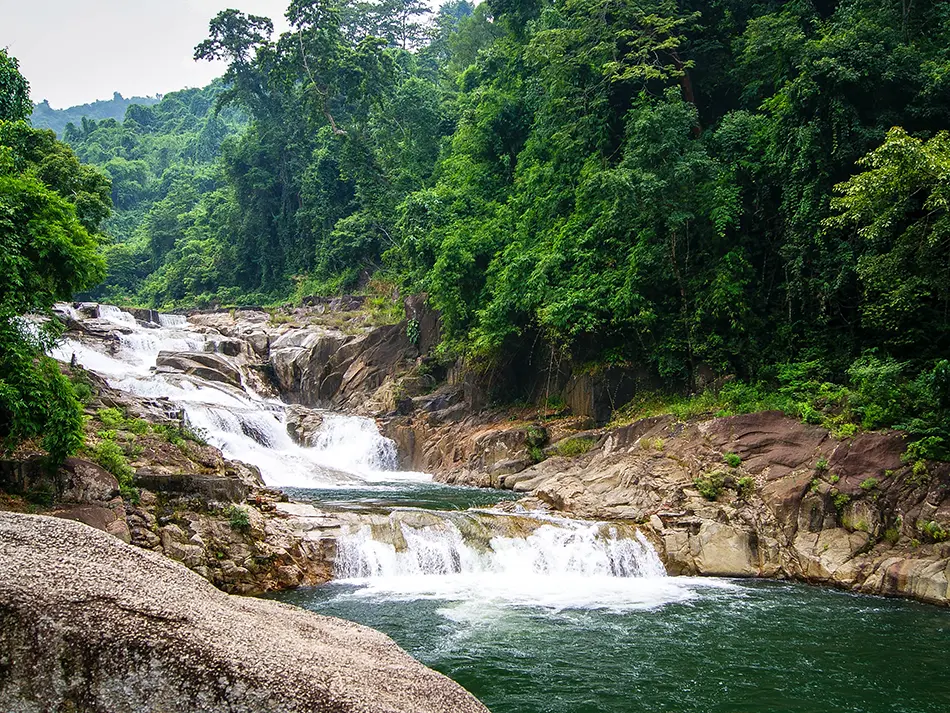
Set in Khanh Hoa province, about 45 minutes inland from Nha Trang, Yang Bay Waterfall is part of a larger eco-park developed around a Raglay ethnic village. The main waterfall flows through a tropical forest into wide rock pools, making it ideal for swimming and family picnics. Beyond the falls, the area features small performances, a wildlife park, and scenic trails.
Getting there:
Roughly 45 minutes (25 mi / 45 km) inland from Nha Trang, with well-marked roads and transport options including taxis and guided tours.
Best time to visit:
May to October, when water flow is strongest and trees are thick with leaves.
Entrance price:
From $6.50–$10 (150,000–250,000 VND) depending on activities included.
Fun Fact
“Yang Bay” means “Heavenly Waterfall” in the Raglay language — the site blends nature and culture, making it more than just a photo stop.
Dray Nur Waterfall — A Thunderous Wonder in the Central Highlands
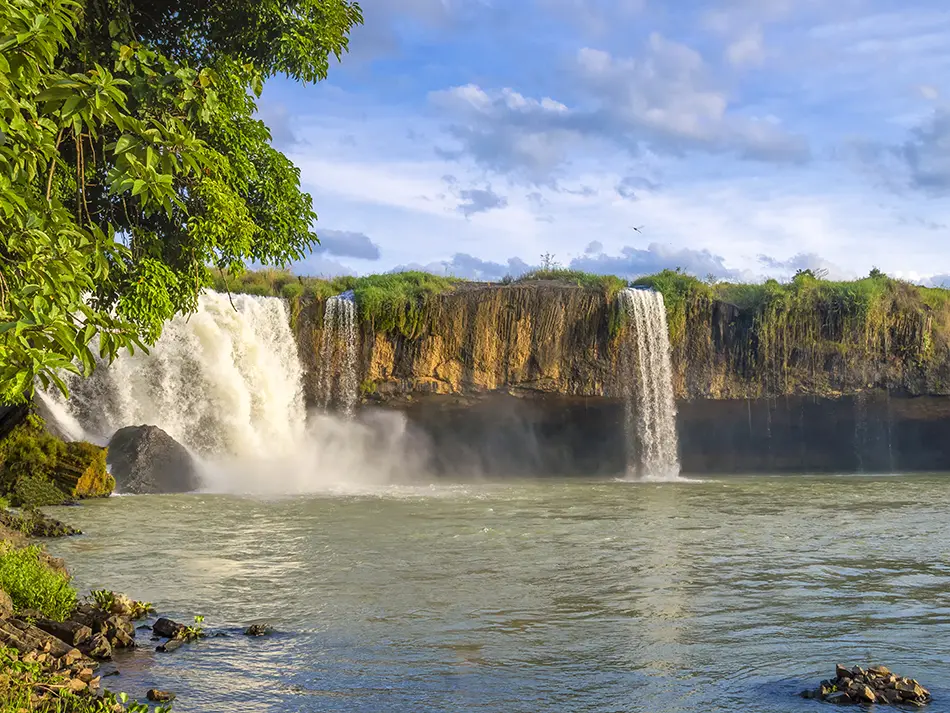
Dray Nur is one of the most powerful and visually striking waterfalls in the Central Highlands, located in Dak Lak province, near Buon Ma Thuot. Fed by the Srepok River, this waterfall spans over 820 feet (250 meters) wide and falls from a height of about 98 feet (30 meters). Behind the curtain of water, visitors can find small caves and stone paths for closer views.
Getting there:
About 15 miles (24 km) from Buon Ma Thuot City. Motorbikes and taxis are both available, and the road is in good condition.
Best time to visit:
July to October for peak water flow.
Entrance price:
Roughly $2 (50,000 VND).
Insider Tip
Pair it with a visit to Dray Sap Waterfall, located just upstream — the two are connected by forest trails and make for a great half-day trip.
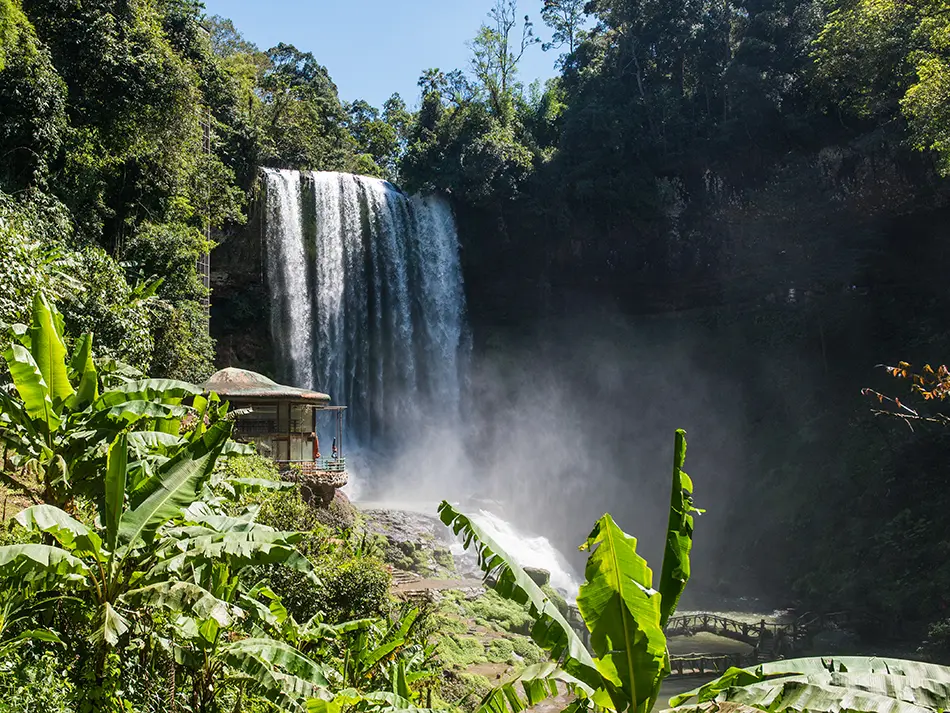
Dambri Waterfall is one of the highest in southern Central Vietnam, plunging about 187 feet (57 meters) into a jungle basin. Surrounded by dense forest in Lam Dong province, the area has been developed into a nature park with walking trails, a mini train, and even a camping site, making it a favorite among local families and adventure lovers alike.
Getting there:
Around 2.5 hours (80 mi / 130 km) south of Da Lat near Bao Loc, with frequent buses and local taxis available for the final stretch.
Best time to visit:
May to November — the rainy season gives the falls extra power, and mist adds to the forest atmosphere.
Entrance price:
Approx. $2.80 (70,000 VND) per adult.
Thuy Tien Waterfall — A Quiet, Triple-Tiered Cascade
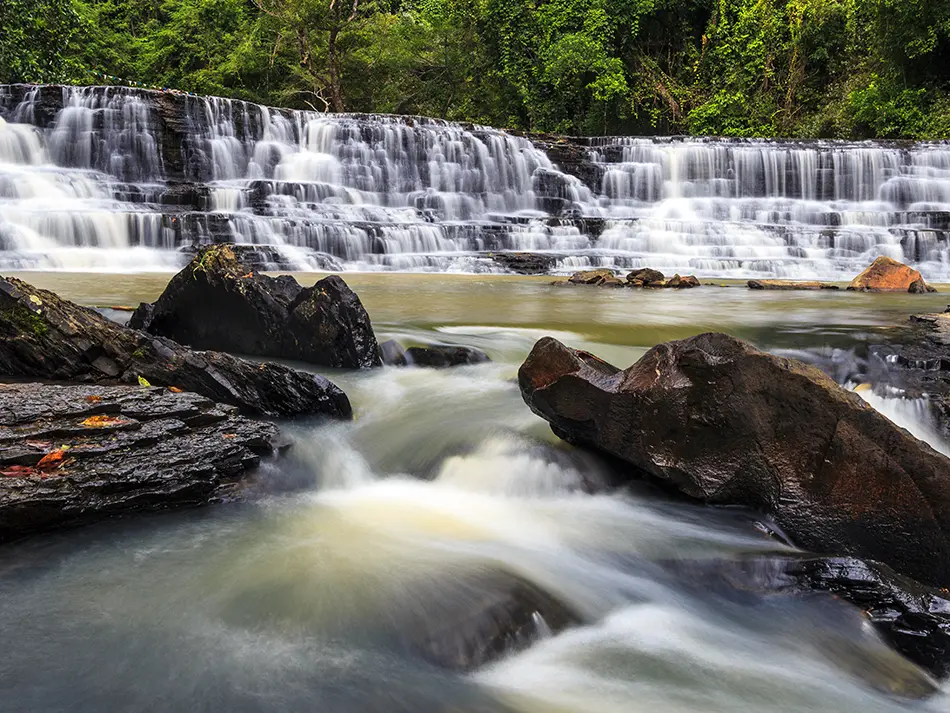
Located in Dak Lak province, Thuy Tien Waterfall is known for its three distinct layers and calm atmosphere. Unlike louder tourist hotspots, this one draws mostly locals and travelers looking for a quiet nature break. The surrounding forest and small lake create a peaceful setting for photos or a short dip.
Getting there:
Roughly 1.5 hours (35 mi / 55 km) northeast of Buon Ma Thuot. Motorbike or private car is the most convenient way to reach the site.
Best time to visit:
June to October — waterfalls are strongest and forest trails stay green.
Entrance price:
Free or up to $0.80 (20,000 VND) depending on maintenance periods.
Fun Fact
The name “Thuy Tien” means “fairy water” in Vietnamese — and the peaceful surroundings live up to that.
Pongour Waterfall — A Layered Giant Near Da Lat

Often called the “Queen of the Central Highlands’ waterfalls,” Pongour is a wide, terraced cascade about 131 feet (40 meters) high and 328 feet (100 meters) wide. What makes it stand out is its unique rock formation — water flows over multiple natural steps, creating a dramatic scene that draws both photographers and local couples taking wedding photos.
Getting there:
Located about 1 hour (30 mi / 50 km) south of Da Lat, with easy access via motorbike or taxi along Highway 20.
Best time to visit:
August to October, when the terraced falls are full and the surrounding fields turn bright green.
Entrance price:
Around $1.20 (30,000 VND).
Phu Cuong Waterfall — Red Rock and Wild Highlands Scenery

Phu Cuong Waterfall is located in Gia Lai province, about 1 hour south of Pleiku, and it’s one of the most beautiful but lesser-known spots in the Central Highlands. The water drops from a height of around 135 feet (40 meters) and flows over striking red volcanic rock, surrounded by dense greenery and basalt cliffs. It’s a peaceful escape far from tourist crowds.
Getting there:
Around 1 hour (25 mi / 40 km) south of Pleiku, Gia Lai’s provincial capital. Most visitors use private transport, as public options are limited.
Best time to visit:
June to October, when the waterfall is strongest and the landscape is at its greenest.
Entrance price:
About $1.60 (40,000 VND).
Ba Ho Waterfall — Natural Rock Pools Near Nha Trang

Ba Ho, which means “Three Lakes,” is a series of three falls and natural pools tucked into the forested hills north of Nha Trang. It’s one of the best places in the region for a short hike followed by a swim. The trail to the top falls can be slippery and steep, but the effort is rewarded with secluded pools and boulders perfect for jumping.
Getting there:
From Nha Trang city, it’s about 16 miles (25 km) north — a 40-minute drive by motorbike or taxi. Some hostels also offer group rides.
Best time to visit:
July to October, for fuller pools and cooler swimming temperatures.
Entrance price:
Approx. $2 (50,000 VND).
Elephant Falls (Thác Liêng Rơwoa) — A Wild Cascade Near Da Lat
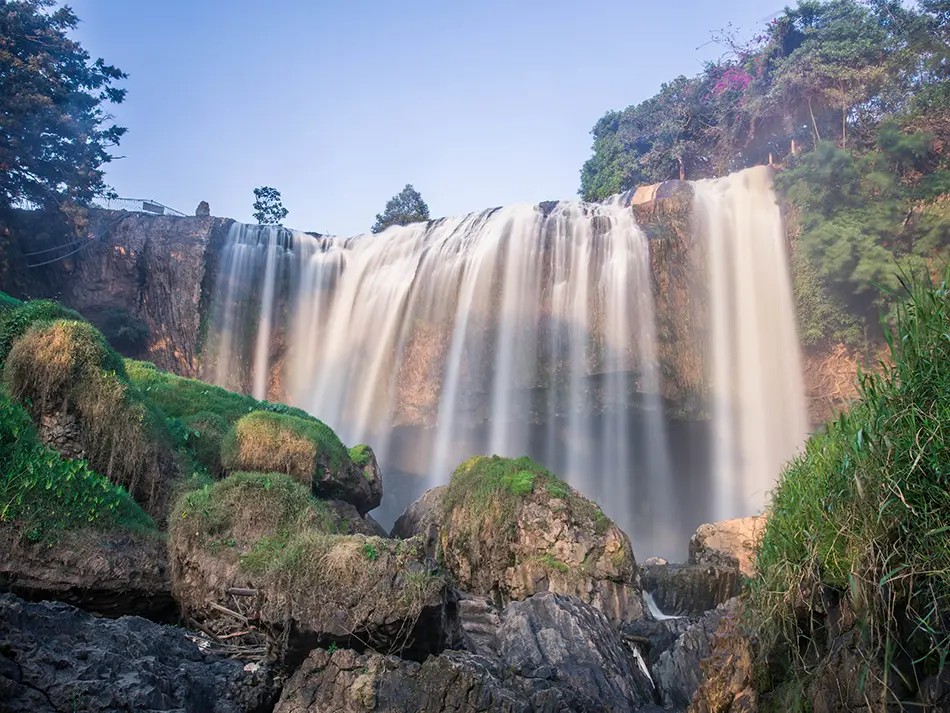
Elephant Falls is one of the most visited waterfalls around Da Lat, known for its thundering flow and the rock formations that resemble elephant skin. At about 98 feet (30 meters) tall and located near Nam Ban village, this is a good spot for half-day nature trips out of the city. Though touristy, the site retains a raw feel thanks to the rough stairs and spray-filled rocks.
Getting there:
Just 17 miles (27 km) southwest of Da Lat, it’s about a 45-minute drive by car or motorbike. Roads are good, and the site is clearly marked.
Best time to visit:
May to November, when rainfall feeds the strong flow.
Entrance price:
About $0.80 (20,000 VND).
Prenn Falls — A Tourist-Friendly Waterfall Close to Da Lat
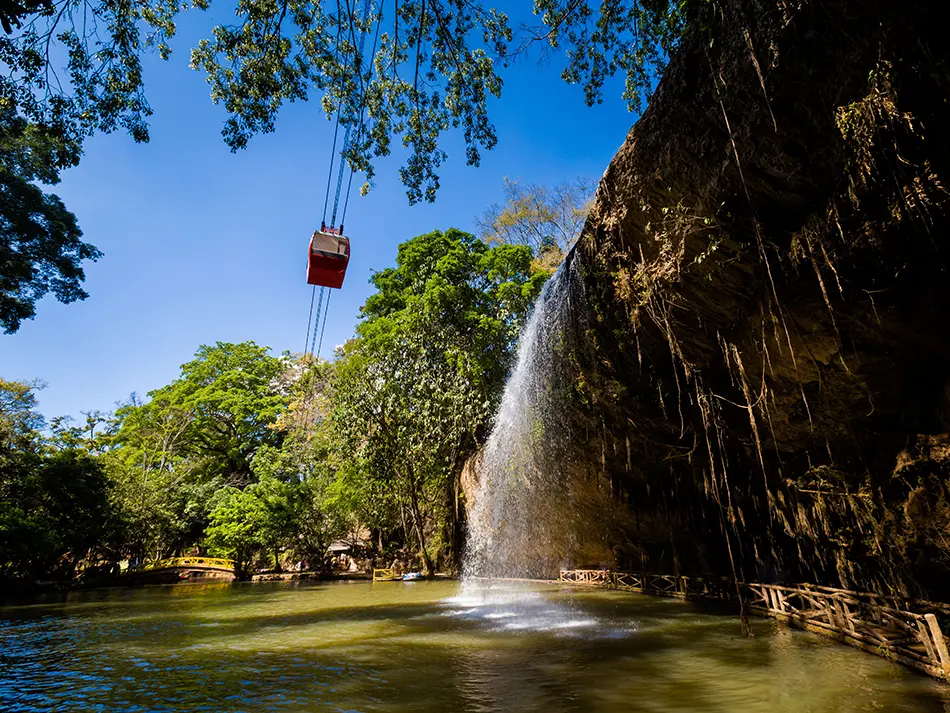
Prenn is one of the most accessible waterfalls near Da Lat, located at the base of the mountain pass leading into the city. At only 33 feet (10 meters) tall, it’s not the most powerful, but it makes up for it with a scenic location and extra activities — including a cable car and boat rides.
Eco Reminder:
While Prenn Falls is a popular park, it’s also known for keeping wild animals — including tigers — in poor conditions. We include this place for informational purposes, but we do not recommend visiting or supporting attractions that exploit wildlife.
Getting there:
From Da Lat city center, it’s just 6 miles (10 km) south — a 15-minute drive by taxi or motorbike. You’ll see clear signage from the main road.
Best time to visit:
Year-round, though it’s best during the rainy season (May to October) when the waterfall is fuller.
Entrance price:
Around $4 (100,000 VND) including some activities.
Datanla Waterfalls — Adventure and Water Coasters in Da Lat
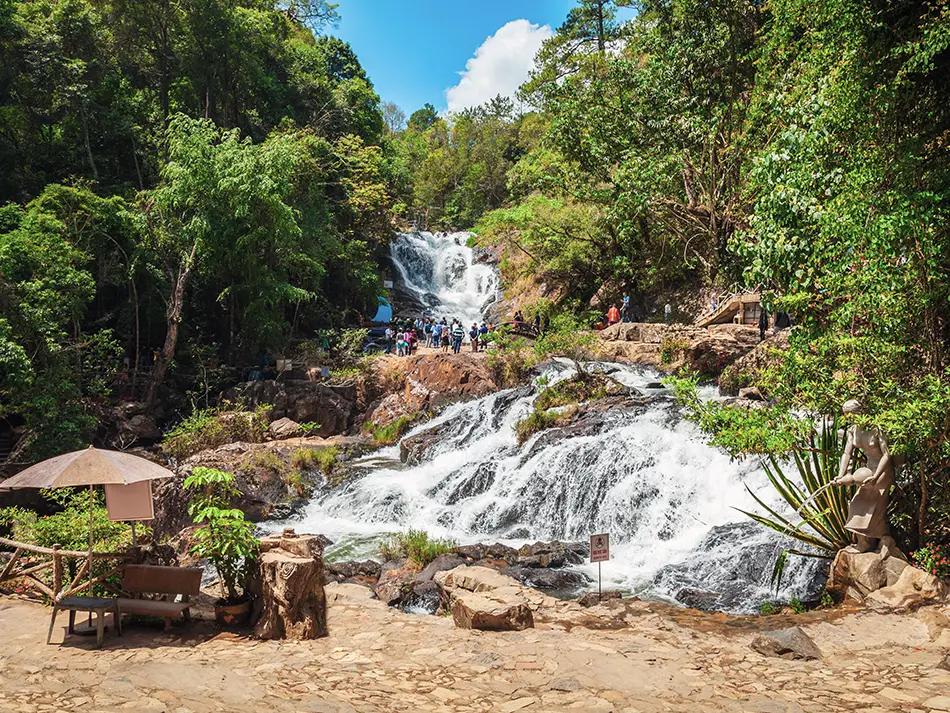
Datanla is the most visited waterfall in Da Lat, not just for its scenic cascades but for the range of adventure activities offered. The falls drop down several short sections, and visitors can explore the area by alpine coaster, cable car, or even rappel down the rocks as part of a canyoning tour. The water is clear, and the forested surroundings make it feel far from the city despite being very close.
Getting there:
Only 3 miles (5 km) south of Da Lat, it’s an easy 10-minute ride. You can take a Grab or a taxi.
Best time to visit:
May to October, when the water flow is stronger for canyoning.
Entrance price:
From $2 (50,000 VND) for basic entry. Extra fees apply for coaster rides and adventure packages.
Bonus: Bao Dai Waterfall — Remote and Untamed

Bao Dai Waterfall (Thác Bảo Đại) is a lesser-known cascade located south of Da Lat, named after Vietnam’s last emperor, Bao Dai, who once favored the area for hunting retreats. Despite the royal connection, the site today is anything but luxurious.
The waterfall drops through dense forest in a half-developed, mostly abandoned park. You’ll find no tourist crowds, little signage, and a raw, untamed atmosphere that appeals to those who prefer quiet nature over manicured parks.
Getting there:
Located about 1.5 hours (31 mi / 50 km) south of Da Lat. The road is paved most of the way, but the final stretch requires navigating a rough trail. Motorbike or private car recommended.
Best time to visit:
June to November, during and just after the rainy season, when the water flow is strongest.
Entrance price:
Free, though occasional locals may collect a small fee for parking or trail access.
Good to Know
There are no facilities here — bring water, good shoes, and let someone know where you’re going. This spot is only for confident travelers looking to explore something raw and undeveloped.
Southern Vietnam Waterfalls: Easy Day Trips and Family-Friendly Spots
Suoi Tranh Waterfall — A Forest Hideaway on Phu Quoc Island

Suoi Tranh Waterfall is a small but charming spot tucked in the forested hills of Phu Quoc Island, in Kien Giang province. The waterfall is only around 13 feet (4 meters) high but flows gently over mossy rocks, surrounded by walking trails, a sculpture garden, and picnic areas. It’s a peaceful stop for visitors who want a break from the beach.
Getting there:
From Duong Dong, the island’s main town and tourist center, it’s just 4 miles (6 km) east — about a 15-minute motorbike or taxi ride.
Best time to visit:
May to September, during the rainy season — in the dry season, there may be little or no water.
Entrance price:
Around $0.80 (20,000 VND).
Giang Dien Waterfall — A Tranquil Park Near Ho Chi Minh City
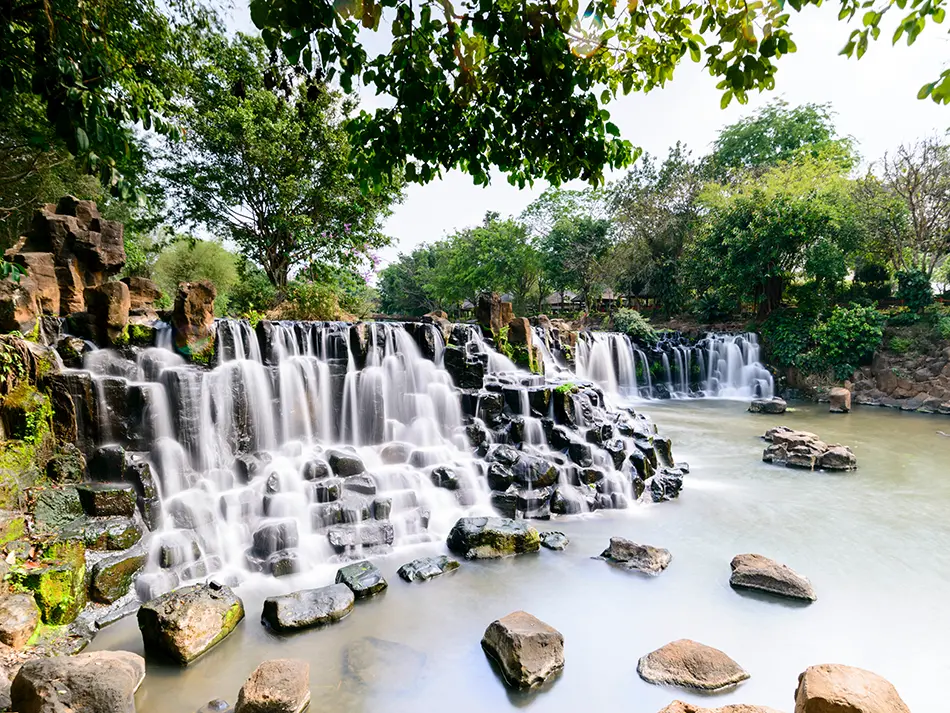
Giang Dien Waterfall sits in Dong Nai province, less than 2 hours from Ho Chi Minh City, making it a popular weekend escape for city dwellers. The waterfall is not particularly tall or wild, but it’s part of a landscaped eco-park with well-maintained trails, cafes, and shaded rest areas. It’s ideal for a laid-back day in nature with minimal hassle.
Getting there:
From Ho Chi Minh City (District 1), it’s about 28 miles (45 km) northeast — 1.5 to 2 hours by car or motorbike depending on traffic. Tours and buses also operate on weekends.
Best time to visit:
June to October, when the river is fuller and the park is green.
Entrance price:
Approx. $2.80–$4.00 (70,000–100,000 VND) depending on package.
Insider Tip
You can rent huts, grills, and even camping space inside the park — it’s designed for full-day visits or group gatherings.
Which Region Has the Best Waterfalls in Vietnam?
If you’re looking for size and drama, Northern Vietnam delivers with places like Ban Gioc and Tac Tinh — expect tall, powerful falls surrounded by mountains.
Central Vietnam has the most variety, especially around Da Lat and the Central Highlands, with waterfalls like Pongour, Datanla, and Dray Nur offering both scenic views and adventure options.
Southern Vietnam has fewer options, and they tend to be smaller and more developed, but they’re easier to reach from major cities like Ho Chi Minh City or Phu Quoc.
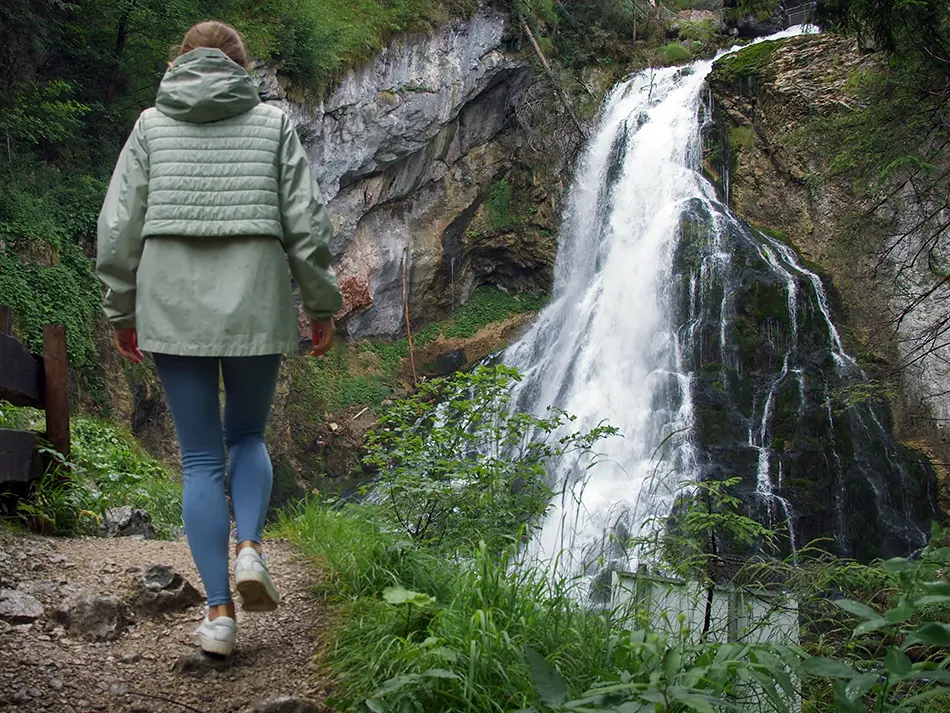
When Should You Go?
The rainy season (May to October) is the best time to visit most waterfalls across the country. Water levels are higher, flows are stronger, and the surrounding areas are greener. However, some remote roads can become muddy or slippery, so check accessibility if you’re traveling during peak rains.
In the dry season (November to April), waterfalls in the south may be nearly dry — especially places like Suoi Tranh.
What to Know Before You Go
- Footwear matters: Flip-flops won’t cut it. Wear shoes with grip — many trails involve wet rocks or uneven steps.
- Bring small cash: Entry fees range from $0.80 to $4 (20,000–100,000 VND), and card payment isn’t available.
- Weekdays are quieter: Visit early or midweek to avoid crowds, especially at popular sites like Datanla or Elephant Falls.
- Combine stops: If you’re based in Da Lat, Buon Ma Thuot, or Nha Trang, you can easily fit in multiple waterfalls on a single day trip.

We hope this guide helps you discover some of the best waterfalls in Vietnam — whether you’re chasing views, swimming holes, or just a cool break from the heat. With so many options across the country, you’re sure to find a few favorites of your own. For other travel inspiration, check out our guide to the best places to visit in Vietnam.

